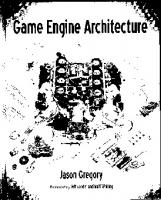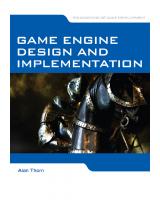Game Engine Architecture [3 ed.] 1138035459, 9781138035454
Covers theory and practice of game engine software development, bringing together a wide range of concepts and technique
650 70 11MB
English Pages 1240 Year 2018
Table of contents :
Cover
Half Title
Title Page
Copyright Page
Dedication
Table of Contents
Preface
I Foundations
1 Introduction
1.1 Structure of a Typical Game Team
1.2 What Is a Game?
1.3 What Is a Game Engine?
1.4 Engine Differences across Genres
1.5 Game Engine Survey
1.6 Runtime Engine Architecture
1.7 Tools and the Asset Pipeline
2 Tools of the Trade
2.1 Version Control
2.2 Compilers, Linkers and IDEs
2.3 Profiling Tools
2.4 Memory Leak and Corruption Detection
2.5 Other Tools
3 Fundamentals of Software Engineering for Games
3.1 C++ Review and Best Practices
3.2 Catching and Handling Errors
3.3 Data, Code and Memory Layout
3.4 Computer Hardware Fundamentals
3.5 Memory Architectures
4 Parallelism and Concurrent Programming
4.1 Defining Concurrency and Parallelism
4.2 Implicit Parallelism
4.3 Explicit Parallelism
4.4 Operating System Fundamentals
4.5 Introduction to Concurrent Programming
4.6 Thread Synchronization Primitives
4.7 Problems with Lock-Based Concurrency
4.8 Some Rules of Thumb for Concurrency
4.9 Lock-Free Concurrency
4.10 SIMD/Vector Processing
4.11 Introduction to GPGPU Programming
5 3D Math for Games
5.1 Solving 3D Problems in 2D
5.2 Points and Vectors
5.3 Matrices
5.4 Quaternions
5.5 Comparison of Rotational Representations
5.6 Other Useful Mathematical Objects
5.7 Random Number Generation
II Low-Level Engine Systems
6 Engine Support Systems
6.1 Subsystem Start-Up and Shut-Down
6.2 Memory Management
6.3 Containers
6.4 Strings
6.5 Engine Configuration
7 Resources and the File System
7.1 File System
7.2 The Resource Manager
8 The Game Loop and Real-Time Simulation
8.1 The Rendering Loop
8.2 The Game Loop
8.3 Game Loop Architectural Styles
8.4 Abstract Timelines
8.5 Measuring and Dealing with Time
8.6 Multiprocessor Game Loops
9 Human Interface Devices
9.1 Types of Human Interface Devices
9.2 Interfacing with a HID
9.3 Types of Inputs
9.4 Types of Outputs
9.5 Game Engine HID Systems
9.6 Human Interface Devices in Practice
10 Tools for Debugging and Development
10.1 Logging and Tracing
10.2 Debug Drawing Facilities
10.3 In-Game Menus
10.4 In-Game Console
10.5 Debug Cameras and Pausing the Game
10.6 Cheats
10.7 Screenshots and Movie Capture
10.8 In-Game Profiling
10.9 In-Game Memory Stats and Leak Detection
III Graphics, Motion and Sound
11 The Rendering Engine
11.1 Foundations of Depth-Buffered Triangle Rasterization
11.2 The Rendering Pipeline
11.3 Advanced Lighting and Global Illumination
11.4 Visual Effects and Overlays
11.5 Further Reading
12 Animation Systems
12.1 Types of Character Animation
12.2 Skeletons
12.3 Poses
12.4 Clips
12.5 Skinning and Matrix Palette Generation
12.6 Animation Blending
12.7 Post-Processing
12.8 Compression Techniques
12.9 The Animation Pipeline
12.10 Action State Machines
12.11 Constraints
13 Collision and Rigid Body Dynamics
13.1 Do You Want Physics in Your Game?
13.2 Collision/Physics Middleware
13.3 The Collision Detection System
13.4 Rigid Body Dynamics
13.5 Integrating a Physics Engine into Your Game
13.6 Advanced Physics Features
14 Audio
14.1 The Physics of Sound
14.2 The Mathematics of Sound
14.3 The Technology of Sound
14.4 Rendering Audio in 3D
14.5 Audio Engine Architecture
14.6 Game-Specific Audio Features
IV Gameplay
15 Introduction to Gameplay Systems
15.1 Anatomy of a Game World
15.2 Implementing Dynamic Elements: Game Objects
15.3 Data-Driven Game Engines
15.4 The Game World Editor
16 Runtime Gameplay Foundation Systems
16.1 Components of the Gameplay Foundation System
16.2 Runtime Object Model Architectures
16.3 World Chunk Data Formats
16.4 Loading and Streaming Game Worlds
16.5 Object References and World Queries
16.6 Updating Game Objects in Real Time
16.7 Applying Concurrency to Game Object Updates
16.8 Events and Message-Passing
16.9 Scripting
16.10 High-Level Game Flow
V Conclusion
17 You Mean There’s More?
17.1 Some Engine Systems We Didn’t Cover
17.2 Gameplay Systems
Bibliography
Index
Cover
Half Title
Title Page
Copyright Page
Dedication
Table of Contents
Preface
I Foundations
1 Introduction
1.1 Structure of a Typical Game Team
1.2 What Is a Game?
1.3 What Is a Game Engine?
1.4 Engine Differences across Genres
1.5 Game Engine Survey
1.6 Runtime Engine Architecture
1.7 Tools and the Asset Pipeline
2 Tools of the Trade
2.1 Version Control
2.2 Compilers, Linkers and IDEs
2.3 Profiling Tools
2.4 Memory Leak and Corruption Detection
2.5 Other Tools
3 Fundamentals of Software Engineering for Games
3.1 C++ Review and Best Practices
3.2 Catching and Handling Errors
3.3 Data, Code and Memory Layout
3.4 Computer Hardware Fundamentals
3.5 Memory Architectures
4 Parallelism and Concurrent Programming
4.1 Defining Concurrency and Parallelism
4.2 Implicit Parallelism
4.3 Explicit Parallelism
4.4 Operating System Fundamentals
4.5 Introduction to Concurrent Programming
4.6 Thread Synchronization Primitives
4.7 Problems with Lock-Based Concurrency
4.8 Some Rules of Thumb for Concurrency
4.9 Lock-Free Concurrency
4.10 SIMD/Vector Processing
4.11 Introduction to GPGPU Programming
5 3D Math for Games
5.1 Solving 3D Problems in 2D
5.2 Points and Vectors
5.3 Matrices
5.4 Quaternions
5.5 Comparison of Rotational Representations
5.6 Other Useful Mathematical Objects
5.7 Random Number Generation
II Low-Level Engine Systems
6 Engine Support Systems
6.1 Subsystem Start-Up and Shut-Down
6.2 Memory Management
6.3 Containers
6.4 Strings
6.5 Engine Configuration
7 Resources and the File System
7.1 File System
7.2 The Resource Manager
8 The Game Loop and Real-Time Simulation
8.1 The Rendering Loop
8.2 The Game Loop
8.3 Game Loop Architectural Styles
8.4 Abstract Timelines
8.5 Measuring and Dealing with Time
8.6 Multiprocessor Game Loops
9 Human Interface Devices
9.1 Types of Human Interface Devices
9.2 Interfacing with a HID
9.3 Types of Inputs
9.4 Types of Outputs
9.5 Game Engine HID Systems
9.6 Human Interface Devices in Practice
10 Tools for Debugging and Development
10.1 Logging and Tracing
10.2 Debug Drawing Facilities
10.3 In-Game Menus
10.4 In-Game Console
10.5 Debug Cameras and Pausing the Game
10.6 Cheats
10.7 Screenshots and Movie Capture
10.8 In-Game Profiling
10.9 In-Game Memory Stats and Leak Detection
III Graphics, Motion and Sound
11 The Rendering Engine
11.1 Foundations of Depth-Buffered Triangle Rasterization
11.2 The Rendering Pipeline
11.3 Advanced Lighting and Global Illumination
11.4 Visual Effects and Overlays
11.5 Further Reading
12 Animation Systems
12.1 Types of Character Animation
12.2 Skeletons
12.3 Poses
12.4 Clips
12.5 Skinning and Matrix Palette Generation
12.6 Animation Blending
12.7 Post-Processing
12.8 Compression Techniques
12.9 The Animation Pipeline
12.10 Action State Machines
12.11 Constraints
13 Collision and Rigid Body Dynamics
13.1 Do You Want Physics in Your Game?
13.2 Collision/Physics Middleware
13.3 The Collision Detection System
13.4 Rigid Body Dynamics
13.5 Integrating a Physics Engine into Your Game
13.6 Advanced Physics Features
14 Audio
14.1 The Physics of Sound
14.2 The Mathematics of Sound
14.3 The Technology of Sound
14.4 Rendering Audio in 3D
14.5 Audio Engine Architecture
14.6 Game-Specific Audio Features
IV Gameplay
15 Introduction to Gameplay Systems
15.1 Anatomy of a Game World
15.2 Implementing Dynamic Elements: Game Objects
15.3 Data-Driven Game Engines
15.4 The Game World Editor
16 Runtime Gameplay Foundation Systems
16.1 Components of the Gameplay Foundation System
16.2 Runtime Object Model Architectures
16.3 World Chunk Data Formats
16.4 Loading and Streaming Game Worlds
16.5 Object References and World Queries
16.6 Updating Game Objects in Real Time
16.7 Applying Concurrency to Game Object Updates
16.8 Events and Message-Passing
16.9 Scripting
16.10 High-Level Game Flow
V Conclusion
17 You Mean There’s More?
17.1 Some Engine Systems We Didn’t Cover
17.2 Gameplay Systems
Bibliography
Index
![Game Engine Architecture [3 ed.]
1138035459, 9781138035454](https://ebin.pub/img/200x200/game-engine-architecture-3nbsped-1138035459-9781138035454.jpg)
![Game Engine Architecture [3 ed.]
1138035459, 978-1138035454](https://ebin.pub/img/200x200/game-engine-architecture-3nbsped-1138035459-978-1138035454.jpg)



![Game Engine Architecture, Second Edition [2nd ed.]
978-1466560017](https://ebin.pub/img/200x200/game-engine-architecture-second-edition-2ndnbsped-978-1466560017.jpg)




